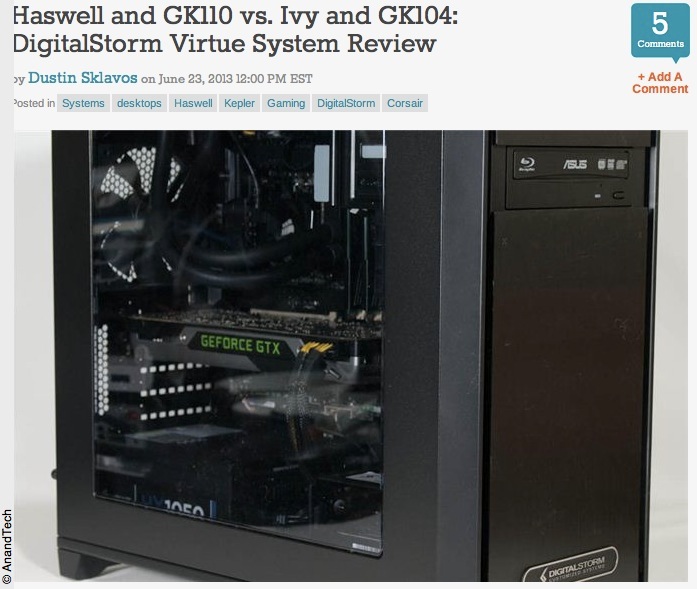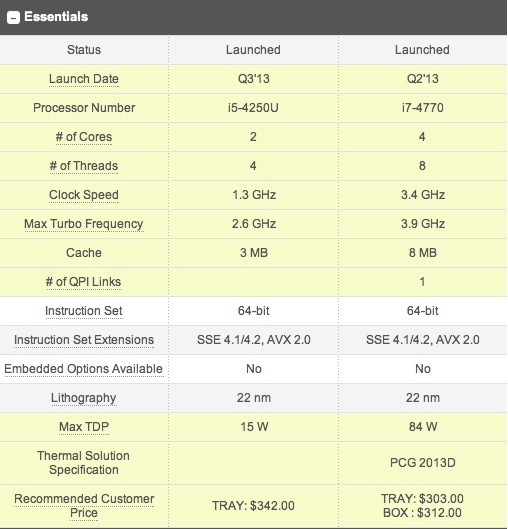Does it make sense to upgrade?
I asked my computer builder FU Steve to pen a few words on upgrades of Intel CPUs in Hackintosh machines.
AnandTech just ran an interesting piece on a high-end PC equipped with an overclocked Intel i7 Haswell CPU, the CPU which obsoletes the current Ivy Bridge. They use a very high-end ($700+) graphics card which muddies the waters somewhat, but their conclusions regarding the new CPU are clear.

Click the picture to read the full review.
AnandTech’s expert has written a fine no-punches-pulled review. It’s a site I like to visit for hard-core analysis compared with the likes of Gizmodo or TechCrunch which mostly seem to uncritically repeat press releases accompanied by puerile writing.
Haswell comes in many flavors (I count over 60 on Intel’s excellent site) but maybe a key comparison is between the i5 mobile version found in the 2013 MacBook Air and the overclocked i7 in the machine reviewed by AnandTech. Here is the comparison from Intel’s site, and I have extracted a section below:

Apart from the speed differences, the desktop Haswells can support 32GB of RAM, compared with a maximum of 16GB for the mobile i5, so for heavy-duty video processing, the desktop version may make sense offering higher CPU speed as well as doubled maximum memory support.
As I wrote earlier, the 2013 MacBook Air is a significant improvement over even the 2012 model, with doubled battery life and 30% faster graphics, making even so early an upgrade seem like common sense. But what about the Hackintosh?
AnandTech’s review, above, concludes that the gains in CPU performance are negligible in moving from Ivy Bridge to Haswell. The low 70 watt idle power consumption is hardly a reason to upgrade; Thomas’s HP100+ idles at 100 watts, and that includes a pair of HDDs, a pair of SSDs, a GTX660 GPU, 16GB of RAM, a wi-fi card, a Z68 motherbooard and five fans. 30 watts saved is irrelevant. You will never recover the cost.
Most Hackintosh users have one of Core2Duo/Core2Quad (2010 and prior), Sandy Bridge (2011) or IvyBridge (2012) CPUs in their machines. Here are my thoughts on the wisdom of upgrading.
Intel Atom: Commonly found in hacked netbooks. Upgrade immediately. Way too slow for modern CPU-intensive applications.
Core2Duo/Core2Quad: Thomas’s current Hack started with a Q9550 Core 2Quad, 2.83GHz stock, which I overclocked to 3.6GHz. An upgrade to anything later makes sense, doubling CPU speed. You will need a new motherboard, new, faster memory and a new CPU. It makes sense to jump right to Haswell as it’s the current design. The cheaper i5 is fine for all but heavy video processing, and 8GB is more than adequate. There’s no need to overclock (i5 or i7 with the ‘K’ suffix in the model number can be overclocked and run a few dollars more) unless you are into intense video processing.
For video consider the i7 and 32GB of RAM. For regular still photography processing, no separate GPU is needed, a substantial saving. Just use the integrated HD4600 which comes with the i5 and i7 versions of the CPU.
Used Intel CPUs retain remarkable resale values. There is still strong demand for the Core2Quad and in fact, I sold mine 2 years ago for more than it cost new! Newer graphics boards also make sense. Used ones have little value. The still photographer gets best price/benefit from something like an nVidia GTX 660 (which Thomas now uses) though for most even something as inexpensive as a used 9800GT will be fine. Easily found for $30. The videographer should go with a GTX660ti or GTX680. The latest GTX7xx cards are too bleeding edge to be a safe choice.
Sandy Bridge: No upgrade needed. Ivy Bridge does not offer enough advantage, though you can apply a BIOS update to most Gigabyte motherboards which will permit the use of Ivy Bridge on a Sandy Bridge motherboard as both use the same socket. If you want more CPU speed consider upgrading an i3 to an i5 or an i5 to an i7 for a 50% speed increase from each step. Used Intel CPUs retain remarkable resale values. Sandy Bridge desktop CPUs can support up to 32Gb of RAM.
Ivy Bridge: Upgrading to Haswell makes no sense. You need a new motherboard and CPU for negligible benefits. Ivy Bridge desktop CPUs can support up to 32Gb of RAM.
Thank you, FU.